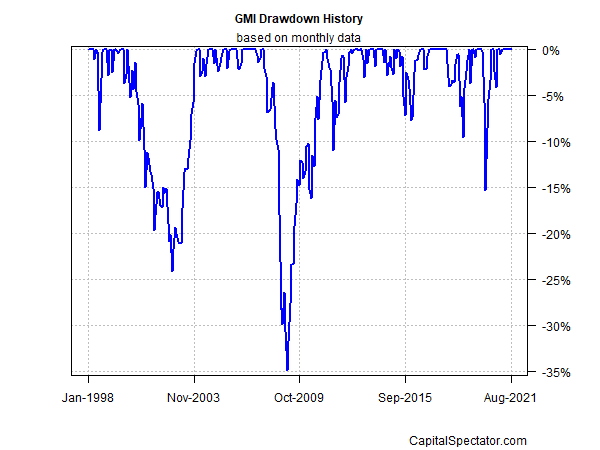Major Asset Classes - Risk Profile - August 2021
Risk-adjusted performance continued to rise in August for the Global Market Index (GMI), an unmanaged, market-value-weighted portfolio that holds all the major asset classes (except cash). GMI’s Sharpe ratio increased for a sixth straight month, reaching 0.93 – the highest in over two years.
GMI’s current Sharpe ratio is at the 98th percentile for the historical distribution (based on rolling 10-year windows that start in 2007). In other words, risk-adjusted performance for this benchmark has rarely been higher.

Not surprisingly, Sharpe ratios in global markets generally are elevated. Ben Breitholtz at Arbor Data Science tweets:
The ‘EVERYTHING RALLY’ is now the longest on record! The average Sharpe ratio across the spectrum of assets has been above 1-to-1 for 270 straight trading days.
Such tightly packed risk-adjusted returns have only occurred ahead of the onset of tightening cycles (2004 and 2015).
Note, too, that GMI’s current Sharpe is exceeded only by two of 14 asset classes that comprise the benchmark: US stocks and US bonds (see data table below for details).
Profiling GMI through a drawdown lens also reveals an extended run of low risk. For a seventh month in row through August, GMI’s peak-to-trough decline has been zero as the index continues to reach new highs.

GMI represents a theoretical benchmark for the “optimal” portfolio. Using standard finance theory as a guide, this portfolio is considered a preferred strategy for the average investor with an infinite time horizon.
Those assumptions are, of course, unrealistic in the real world. Nonetheless, GMI is useful as a baseline to begin research on asset allocation and portfolio design. GMI’s history suggests that this benchmark’s performance is competitive with active asset-allocation strategies overall, especially after adjusting for risk, trading costs and taxes.
For added context, readers can use this basic risk profile for GMI alongside the current monthly updates on performance and expected return for the benchmark and its components.
The table below presents additional risk metrics for GMI and its underlying asset classes, based on a trailing 10-year window through last month.

Here are brief definitions of each risk metric:
Volatility: annualized standard deviation of monthly return
Sharpe ratio: ratio of monthly returns/monthly volatility (risk-free rate is assumed to be zero)
Sortino ratio: excess performance of downside semivariance (assuming 0% threshold target)
Ulcer Index: duration of drawdowns by selecting negative return for each period below the previous peak or high water mark
Maximum Drawdown: the deepest peak-to-trough decline
Beta: measure of volatility relative to a benchmark (in this case GMI)
Disclosures: None.



